1999 Connecticut Quarter Coin Value: How Much Is It Worth?
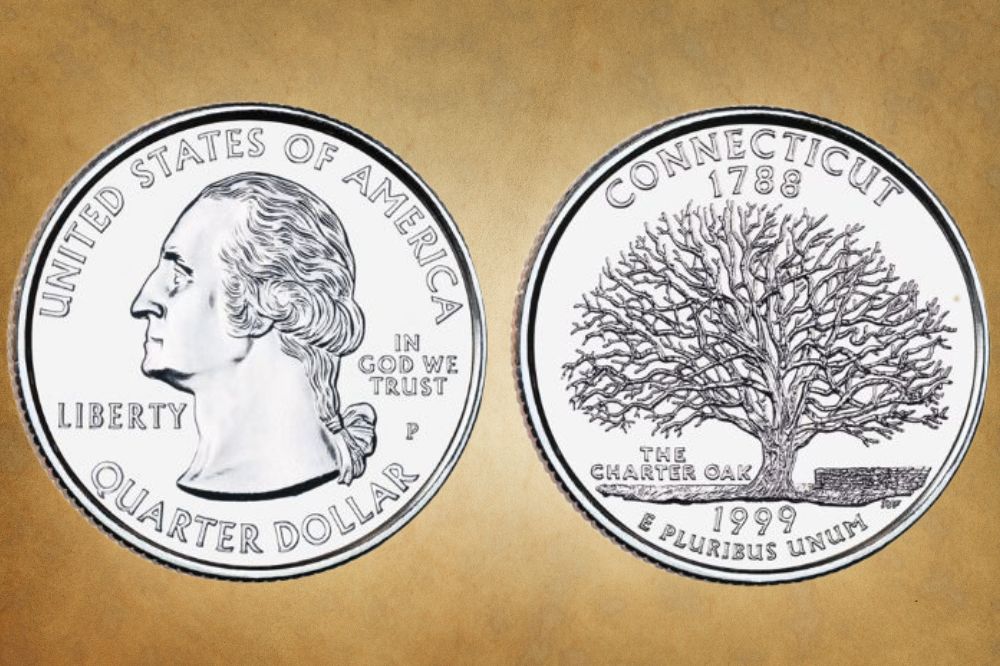
If you were around back in 1999, you might remember how it felt like the end of the world! We were all concerned about Y2K and disappointed that we hadn’t seen any of the advances promised by Beyond 2000. This Australian tech show imagined the fancy toys we might have in the next millennium. Anyway, let’s dig into the 1999 Quarter Value to see what it’s worth.
1999 Quarter Value Chart |
|||
| Mint Mark | Uncirculated (MS 60) | Mint State (MS 65) | Proof (PR / PF 65) |
| 1999-P Quarter Value | $0.85 | $3.30 | No P-Proofs |
| 1999-S Clad Quarter Value | $0.25 | $0.85 | $7.88 |
| 1999-S Silver Quarter Value | $4.81 | $4.81 | $36 |
| 1999-D Quarter Value | $0.85 | $3.30 | No D-Proofs |
1999 Quarter Value Guide
Aside from condition and errors, the mint mark on the 1999 Quarter can affect its resale value, so let’s look at each coin based on the location where it was minted. For reference, we’ll discuss the mints rather than the individual states, since their values are similar.
1999-D Quarter Value
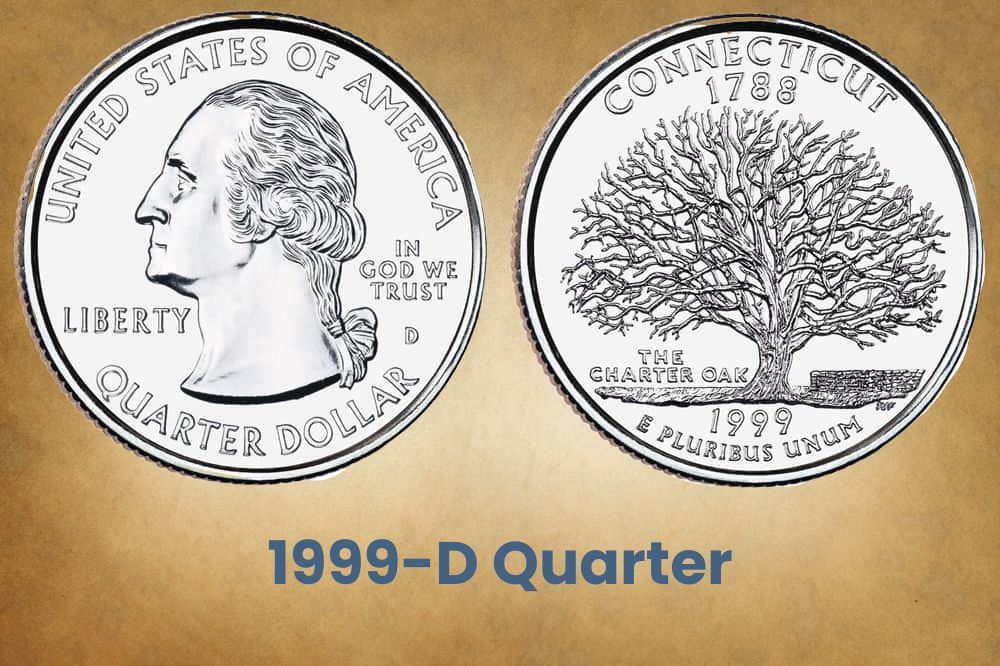
In 1999, the Denver Mint made Clad Quarters for all five states. They carried the D Mint Mark, and their mintage figures are described below. D Mint Marks are often low quality.
- Pennsylvania – 358,332,000
- New Jersey – 299,028,000
- Delaware – 401,424,000
- Connecticut – 657,880,000
- Georgia – 488,744,000
In higher grades like MS 68, a 1999-D Quarter from pretty much any state goes for $5,000, though 1999-D Quarters from Pennsylvania can sometimes hit premiums of $7,500 or more.
1999-P Quarter Value
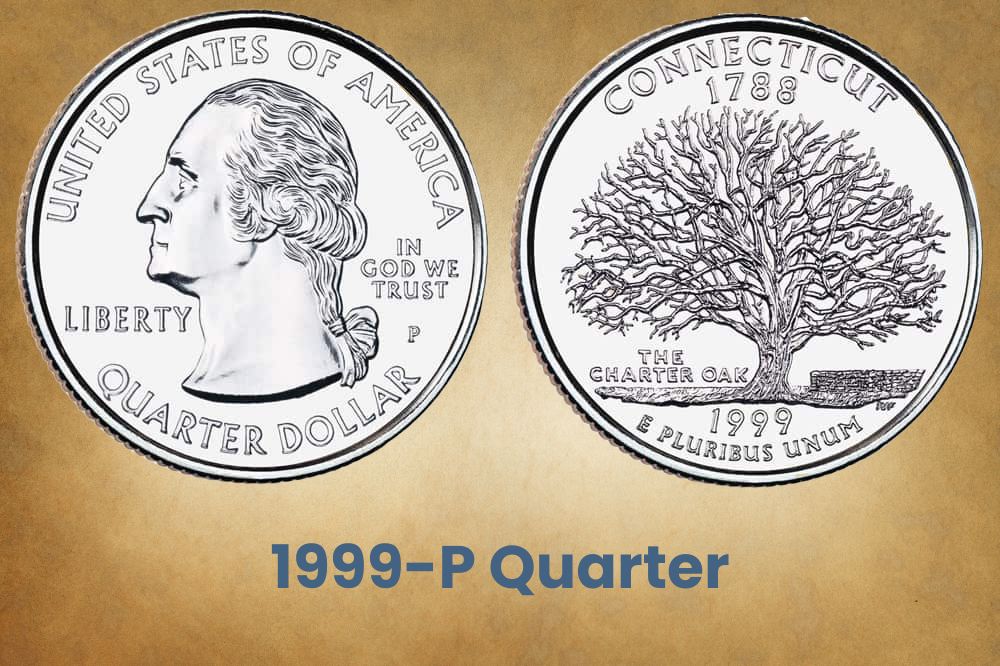
While these coins are evaluated within the same range, let’s start by looking at volumes. In 1999, the Philadelphia Mint produced the following coins with P Mint Marks for each state:
- Pennsylvania – 349,000,000
- New Jersey – 363,200,000
- Delaware – 373,400,000
- Connecticut – 688,744,000
- Georgia – 451,188,000
In the near-perfect grade of MS 69, a 1999-P Pennsylvania Quarter sold for $7,050 in 2017 while an MS 69-P Connecticut shot even higher to $10,500. These are conditional rarities.
1999-S Clad Quarter Value
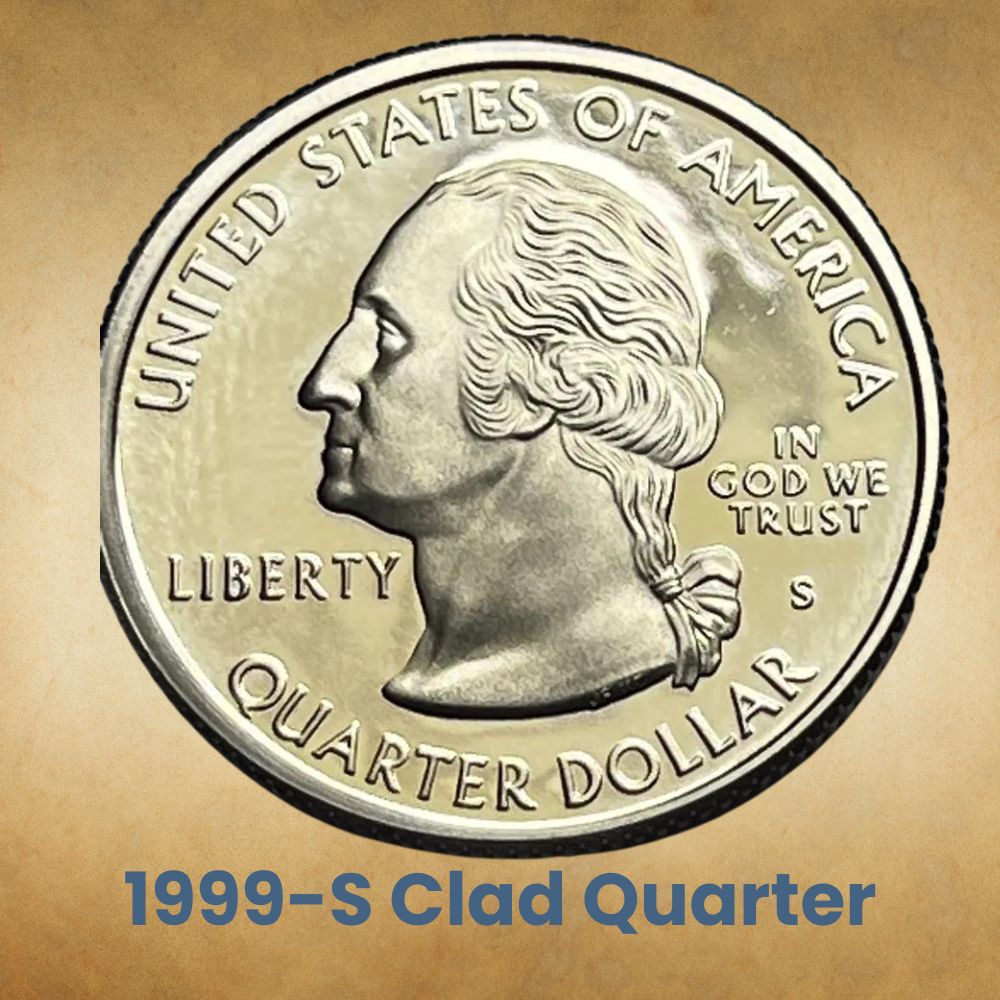
The San Francisco Mint only makes proof coins. They’re minted on pre-burnished planchets and their dies are specially treated. In 1999, Clad S-quarters were minted as shown below:
- Pennsylvania – 3,713,359
- New Jersey – 3,713,359
- Delaware – 3,713,359
- Connecticut – 3,713,359
- Georgia – 3,713,359
Coin collectors target coins from particular mints, so to avoid hoarding, San Francisco minted the same volumes for each state. But they’re only worth $40 even in PR 70 DCAM.
1999-S Silver Quarter Value
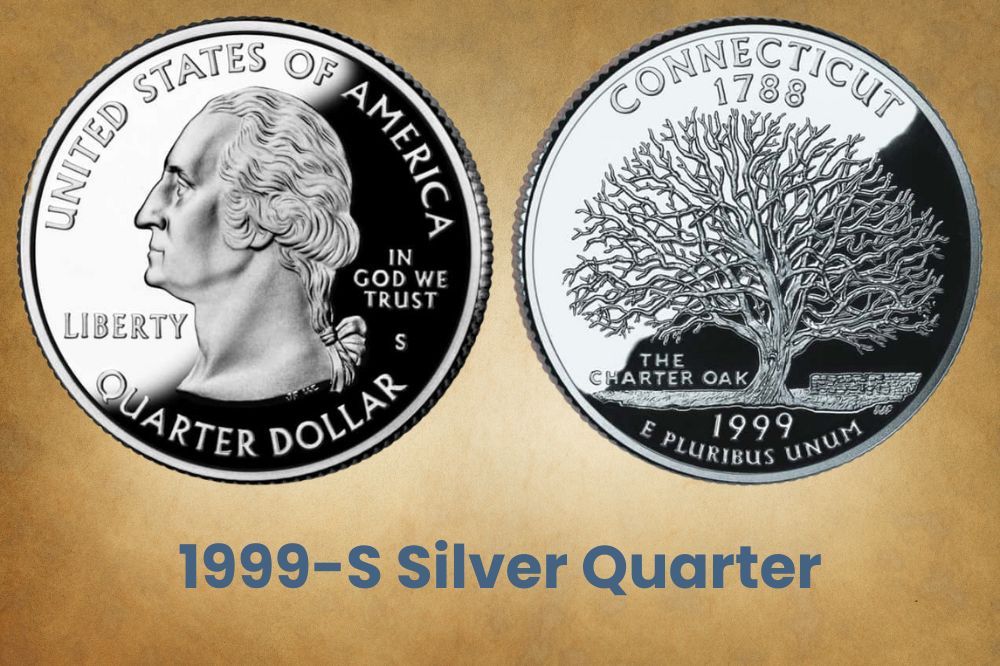
In 1999, San Francisco made both Clad Quarters and Silver Quarters, and both sets were proof quarters. Below are the mintage volumes for the 1999 Silver Quarters for all five states:
- Pennsylvania – 804,565
- New Jersey – 804,565
- Delaware – 804,565
- Connecticut – 804,565
- Georgia – 804,565
As with the clad proof quarters, the same number was made for each state to stop people from hoarding state proofs. But silver proof quarters can only earn $150 in PR 70 DCAM.
Related Posts: 17 Most Valuable Modern Quarters Worth Money
1999 Quarter Errors
1999 doesn’t seem that long ago … until you realize it’s been over 20 years. That’s two whole decades! But in the coin-collecting world, that’s nothing, so these coins haven’t acquired any vintage cred yet. Still, the state coins have historic and sentimental value, so they’re likely to appreciate over time. For now, let’s look at a few important coin errors that raise their value.
1999-D New Jersey Quarter Clip Error
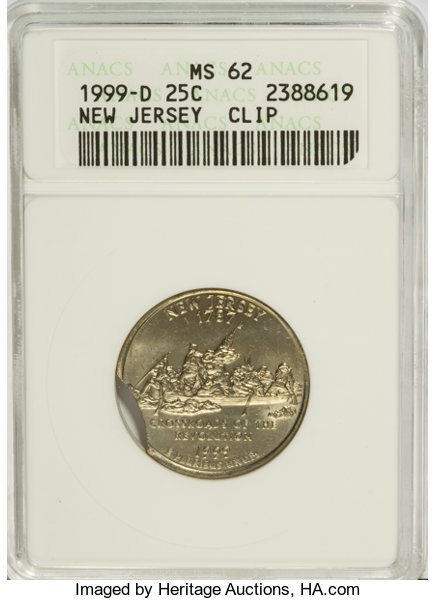
Sometimes, a section of the coin gets sliced off at the mint. One clipped planchet error on a Delaware Quarter chopped off part of the boat at the back, and most of the word Liberty plus part of the Q on the front. Ungraded, it sold for $70 on eBay. Another Georgia Quarter with double curved clips plus an off-center error was graded MS 62 and sold for $325 in 2021.
1999-P Connecticut Quarter Reverse Clad Layer Missing
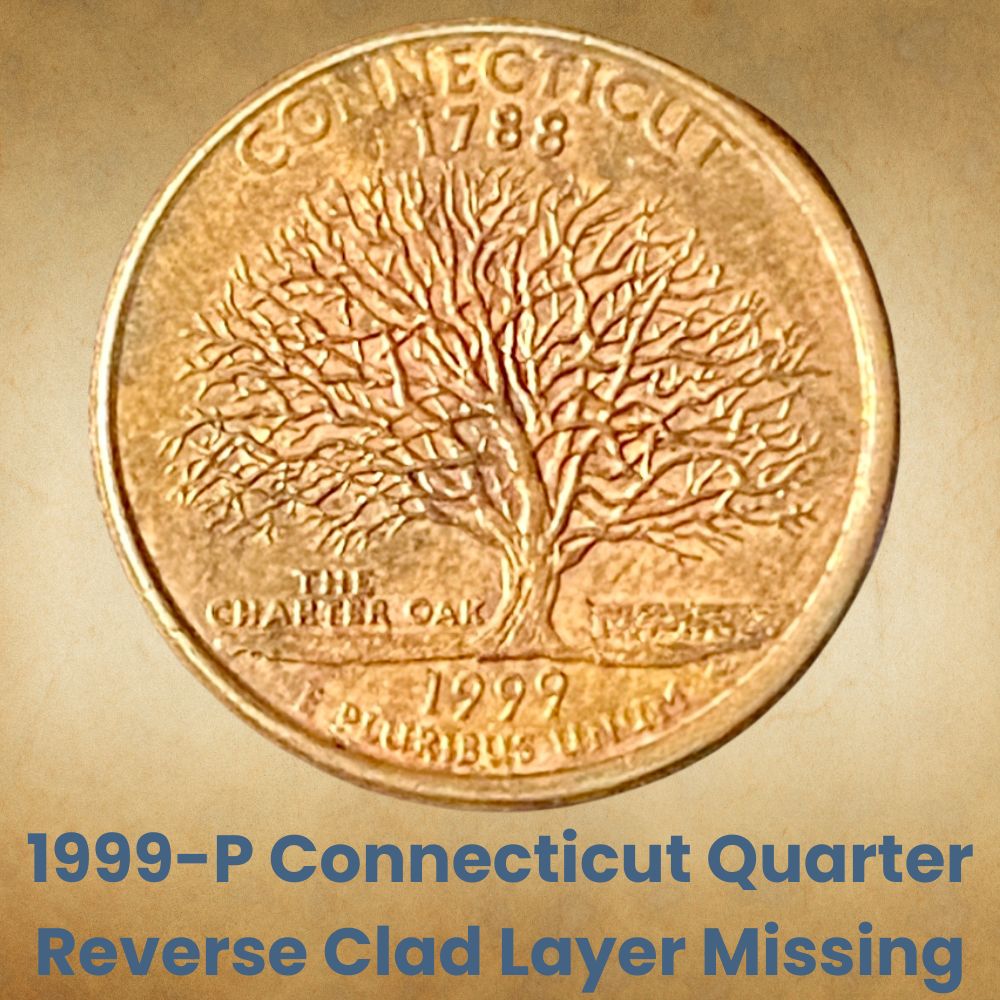
In 1999, most of the 50 State Quarters were cupronickel, though about 4M silver proofs were coined. The clad coins have a pure copper core coated with 75% copper + 25% nickel. So if the clad layer is missing, the coin takes on the coppery color of its core. And this coin has a silvery front with a reddish back. In the high grade of MS 61, the coin sold for $430.
1999 Delaware Quarter Multi Struck on Feeder Finger
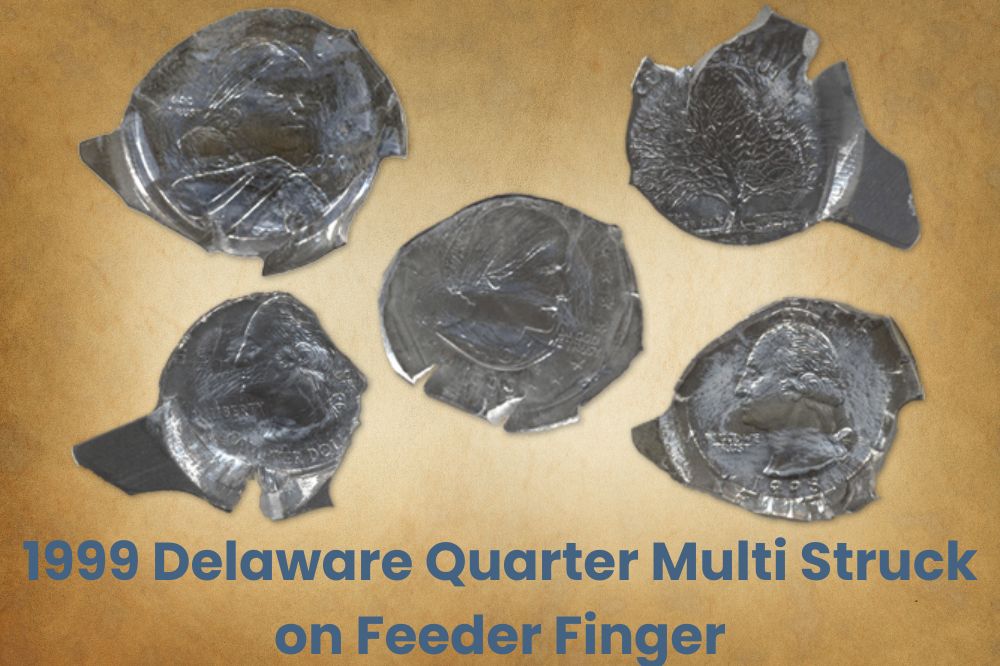
Coins are minted on blank discs called planchets. These are punched off metal sheets then fed into a hopper automatically. Each coin is struck multiple times to ensure clarity and detail. This coin somehow got jammed onto the feeder finger and struck multiple times so it has a weird jagged edge and obscured visuals. In MS 62, the quarter sold for almost $1,000.
1999-P Die Cap Brock Double Struck Quarter
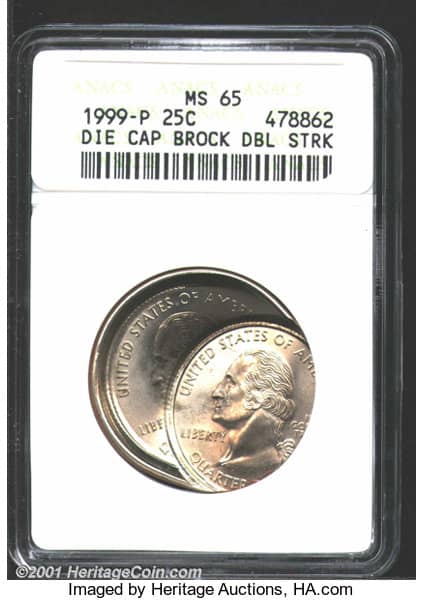
Sometimes, after a coin is minted, it doesn’t exit the machine but instead sticks to the die and stamps the next coin. This is called a die cap error or a brockage error, and it can be worth $173 in MS 63. Then, if the planchet below it moves between strikes, you get a double strike error. This MS 65 Quarter has a brock + a distinct double strike, so it’s worth $1,200.
1999 Quarters Struck Off-Centre
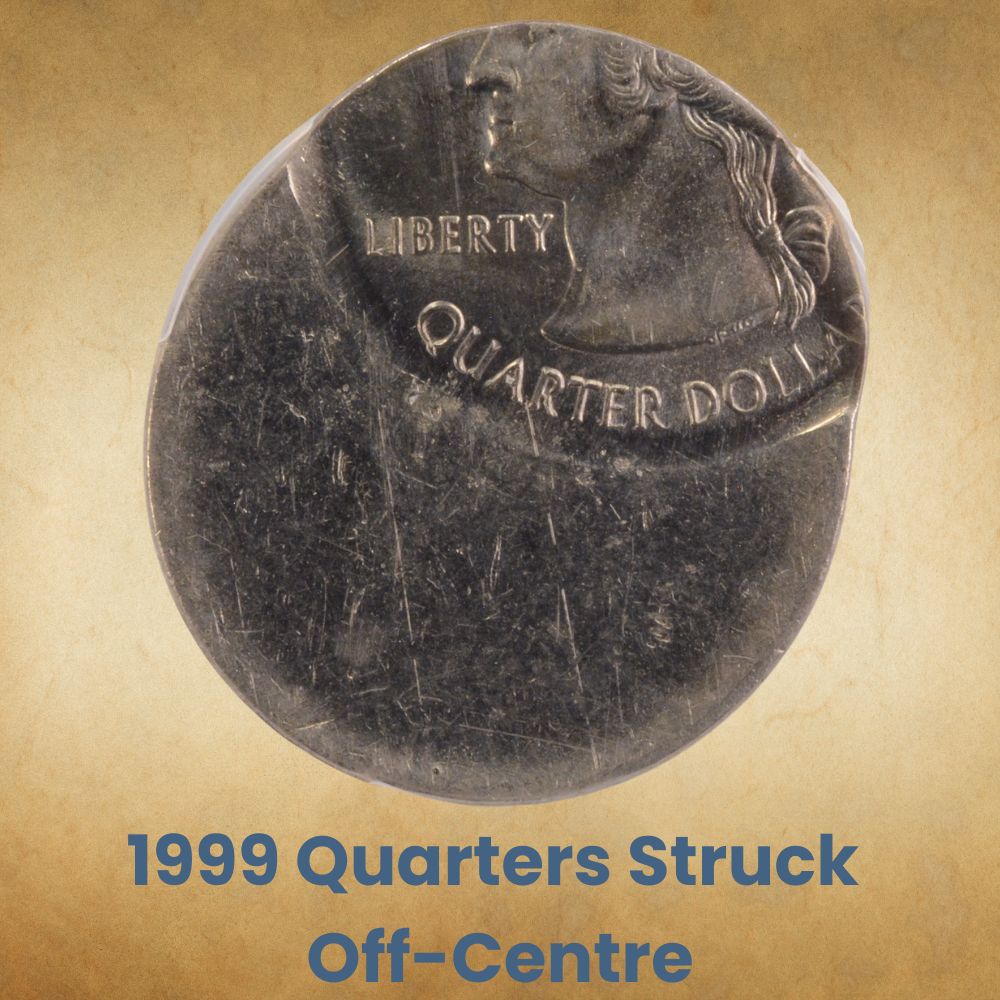
When a planchet shifts between die strikes, you can get off-center errors. They can be double or triple strikes as well. A 10% off-center is worth $100 in MS 64, while a 30% off-center is worth $975 in MS 65. Push that to 35% and it’s worth $600 in MS 67. A misshapen 60% off-center in MS 63 can be $160, while a 65% Figure-8 off-center in MS 65 could sell for $195.
1999 Delaware Quarter Struck 20% Off-Centre on 53% Scrap
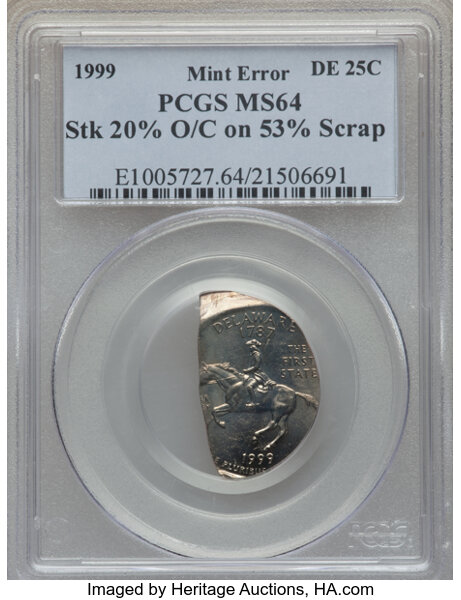
Planchets are punched automatically then robotically fed into the hopper. If they’re well-cut, they get that perfect circular shape. But if anything goes wrong, misshapen fragments or shards of scrap can be loaded into the machine and struck by the die. This seems to be the case here, plus the shard moved mid-strike. In MS 64, this off-center error is worth $400.
1999-P Quarters Struck on Experimental Planchets
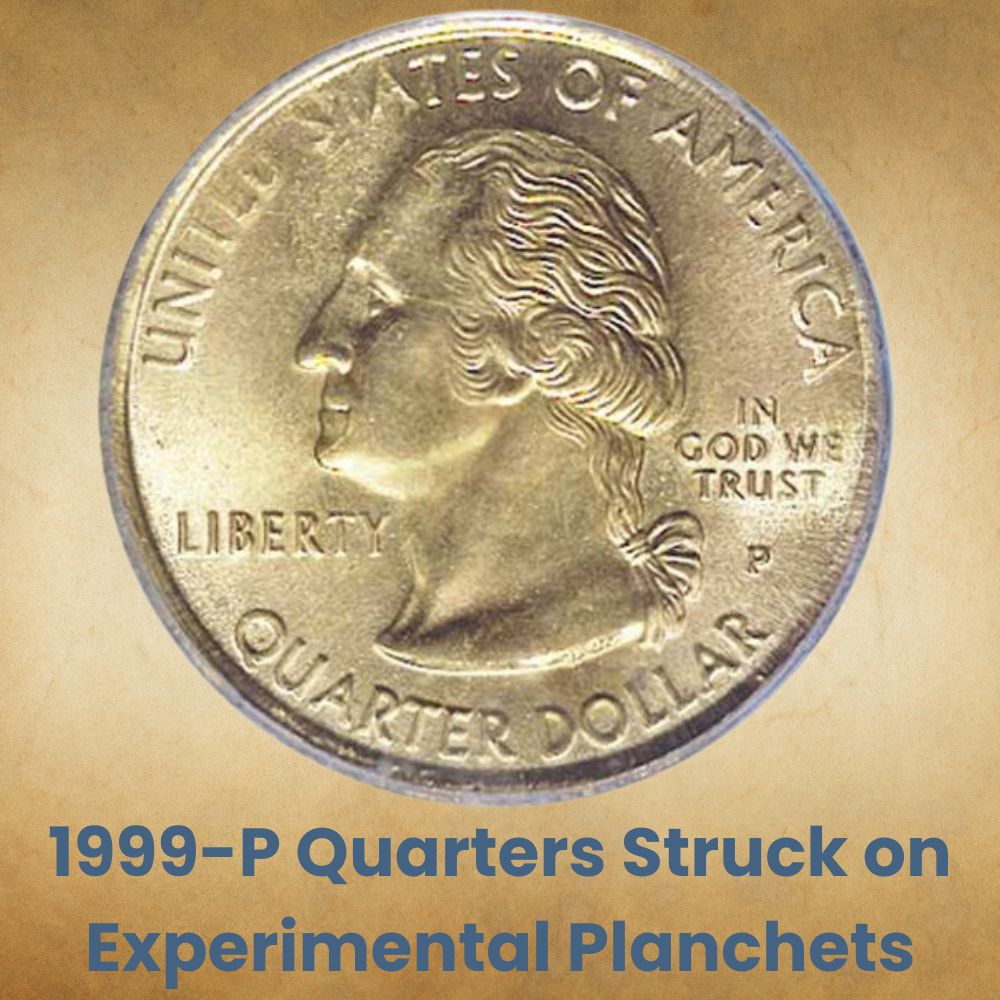
State Quarters were either struck on base metals or silver, but some may have been tested on experimental planchets made from other materials. Check the weight and color. A Delaware Experimental in MS 66 was $4,800; an MS 67 Georgia Experimental was $7,200 in 2020; an MS 66 Connecticut was $5,100 in 2003; and an MS 67 Pennsylvania was $9,800 in 2006.
1999 Quarter Mated + Bonded Pair Error
If two blanks are fed into the machine at the same time, they squeeze together so one surface gets the front design and the other gets the back design, leaving blanks on the two inner surfaces. Or it could be a double strike on overlapping coins, making a mated pair worth $2,000. It could even be a triple strike that mashes two coins together. That’s worth $3,120.
1999 Delaware Die Adjustment Strike
On occasion, the die itself needs to be shifted or tweaked to ensure accuracy. But if the die isn’t set correctly, bad things happen! In this case, an adjustment error led to a coin with barely any imprint. It could be mistaken for an extremely worn-out coin where all the detail has faded, but it was formally graded as a mint error by ANACS. In MS 60, it sold for $150.
1999-P New Jersey Quarter Struck on a 5c Planchet
Planchet sheets have predefined metal compositions and disc sizes. So if you strike a coin on the wrong planchet, it will have a different weight and diameter. That’s why the first thing to do when you get a coin is weigh it to confirm if it’s an off-center or a wrong planchet. This 5g quarter was struck on a nickel planchet. It’s worth $1,600 in mint state and $745 in AU 58.
1999-P Multi-Struck Reverse Die Cap Error
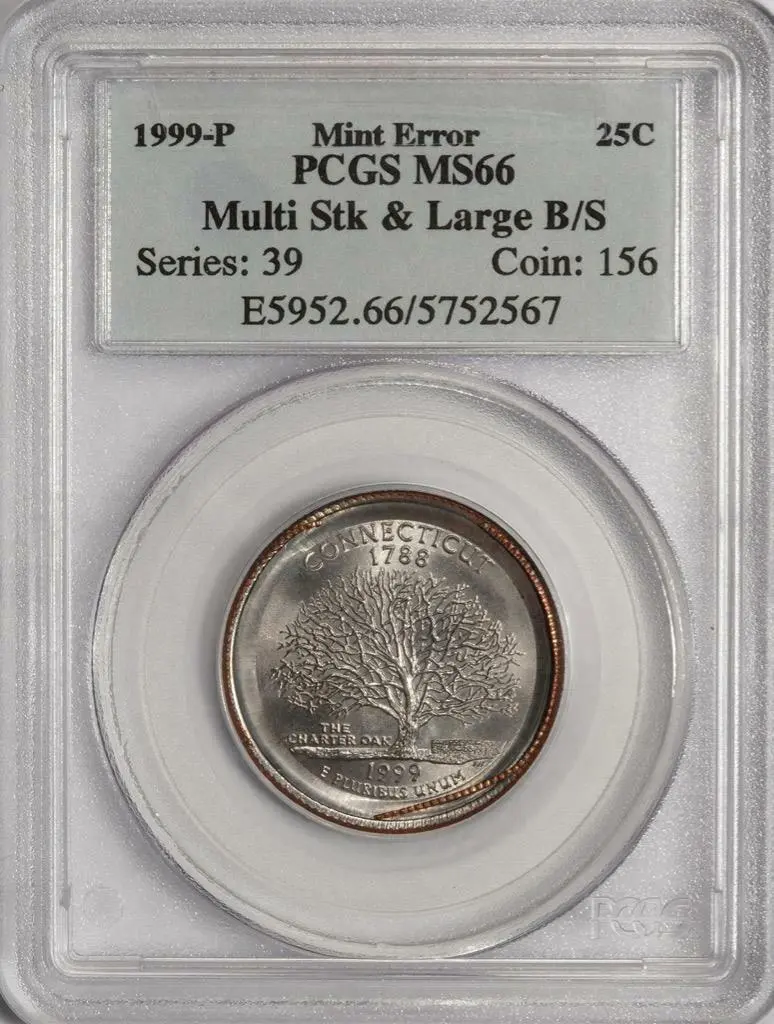
We’ve explained how a die cap happens. And a lot of the time, that stuck disc will eventually slip off and mix with other coins. But before it does, it can obscure the patterns on any coin it strikes, creating blank spot brockages or mangled visuals. This multi-strike die cap blurred the reverse. It’s worth $790 in MS 65; from $900 to $1,400 in MS 66; and $1,600 in MS 67.
1999 Connecticut Obverse Brockage Error
A brockage error can be caused by a die cap or by some other interrupting agent. Sometimes, it leaves one side of the coin blank, but other times, the obverse or reverse design bleeds through to the other side due to the pressure of the strike. In this case, the obverse brockage pressed the Charter Oak on both sides of the coin. Ungraded, it sold for over $3,000 on eBay.
1999-D Georgia Quarter 135° Rotated Reverse
American coins are struck in a head-to-tail 180° alignment. That means if you flip the coin vertically, the design stays upright, but if you flip it horizontally, the designs appear upside down. On this Georgia Quarter, the reverse was positioned at 135° instead of 180°. This error is reasonably valuable, so even in the mid-range grade of AU 58, it’s worth more than $200.
1999 Quarter Triple + Quadruple Strike Error
We’ve seen lots of double-strike errors on this list, but triple and quadruple strikes are rarer. It means the planchet is insecurely attached, no pun intended, and wobbles a lot between strikes, repeatedly veering to the left or right. An MS 60 Connecticut Quarter with a triple strike sold for $575, while an MS 63 Georgia Quarter with a quadruple strike sold for $780.
1999-S Pennsylvania Clad Quarter DDO
On occasion, a die moves while it’s being struck by the hub, causing doubled die errors on the obverse or reverse. These errors are then transferred to every coin made with that die, and since they’re so common, DDRs and DDOs on State Quarters are only worth $10 in mint state. But on clad proof coins, only one DDO has been graded so far. It’s worth over $2,500.
Related Posts: 16 Most Valuable Quarter Errors
History of the 1999 Quarter
An American Quarter or Quarter Dollar is a US coin worth 25 cents. It’s one of the two coin denominations listed in dollars. The backs of smaller coins are mostly marked in cents, but the two larger ones are marked in dollars. We have $1 coins, but they rarely circulate so they mostly live in bank vaults or the display cases of collectors. Below are the coin markings:
- 1c (Penny) – One Cent
- 5c (Nickel) – Five Cents
- 10c (Dime) – One Dime
- 25c (Quarter) – Quarter Dollar
- 50c (No Nickname) – Half Dollar
You’ll note that the 10c coin is marked as One Dime, and it’s the only American coin that officially wears its nickname on its back, but that’s another story. For now, let’s talk quarters. First off, George Washington didn’t believe in putting American leaders on coins. He felt it was too crass, and this was a man who offered his own silver spoons to be turned into coins!
But Washington is the 1st US President, and among the most beloved Founding Fathers, so 200 years after his birth, he was posthumously placed on the 25c coin. He has also appeared on circulating $1 bills since 1869, the Presidential $1 Coin of 1997, and the commemorative $5 gold bullion coin of 1999. The first Washington Quarter portrait was by John Flanagan.
He sculpted it in 1932, and William Cousins made slight modifications in 1999. Coins from 1932 to 1998 have JF at the neckline cut-off while quarters from 1999 to 2021 have both JF and WC for John Flanagan and William Cousins. In 1999, the mint decided to make 50 individual reverses to honor each American state. These were known as 50 States Quarters.
Related Posts: Top 10 Most Valuable Bicentennial Quarters Worth Money
how to identify 1999 Quarter?
1999 Quarters are part of the 50 State Quarters Series that ran from 1999 to 2008. They only released five designs a year though, so the quarters made in 1999 represented Delaware, New Jersey, Pennsylvania, Georgia, and Connecticut. Let’s discuss the key features of these coins.
The Obverse of the 1999 Quarter
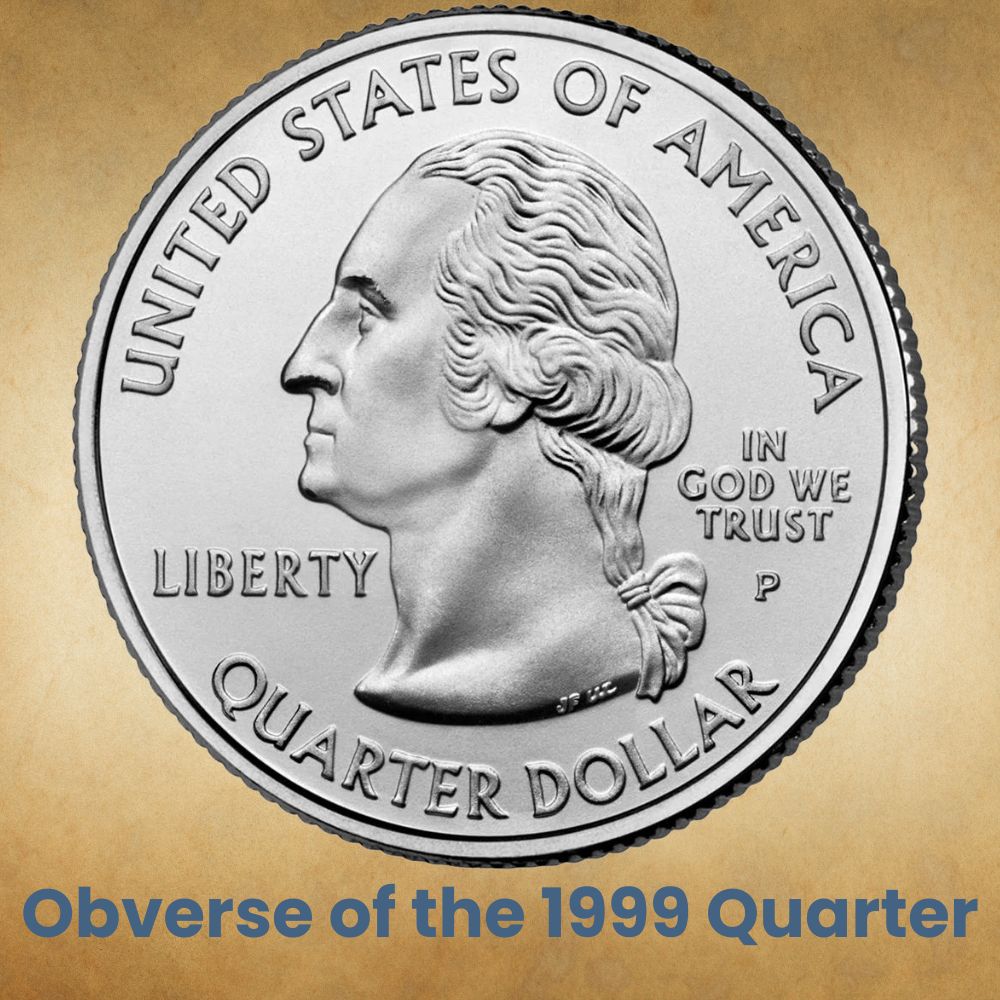
The obverse (heads side) of the 1999 Quarter features a portrait of George Washington facing left. It shows his head, neck, and ponytail, and was originally designed by John Flanagan. It was adapted by William Cousins to make more room for all the additional obverse elements.
The neckline cut-off has JF and WC to credit both designers. Liberty is on the left, under his chin, and In God We Trust is on the right. United States of America was moved to the front and runs along the upper collar of the coin. Quarter Dollar runs along the coin’s lower rim.
The Reverse of the 1999 Quarter
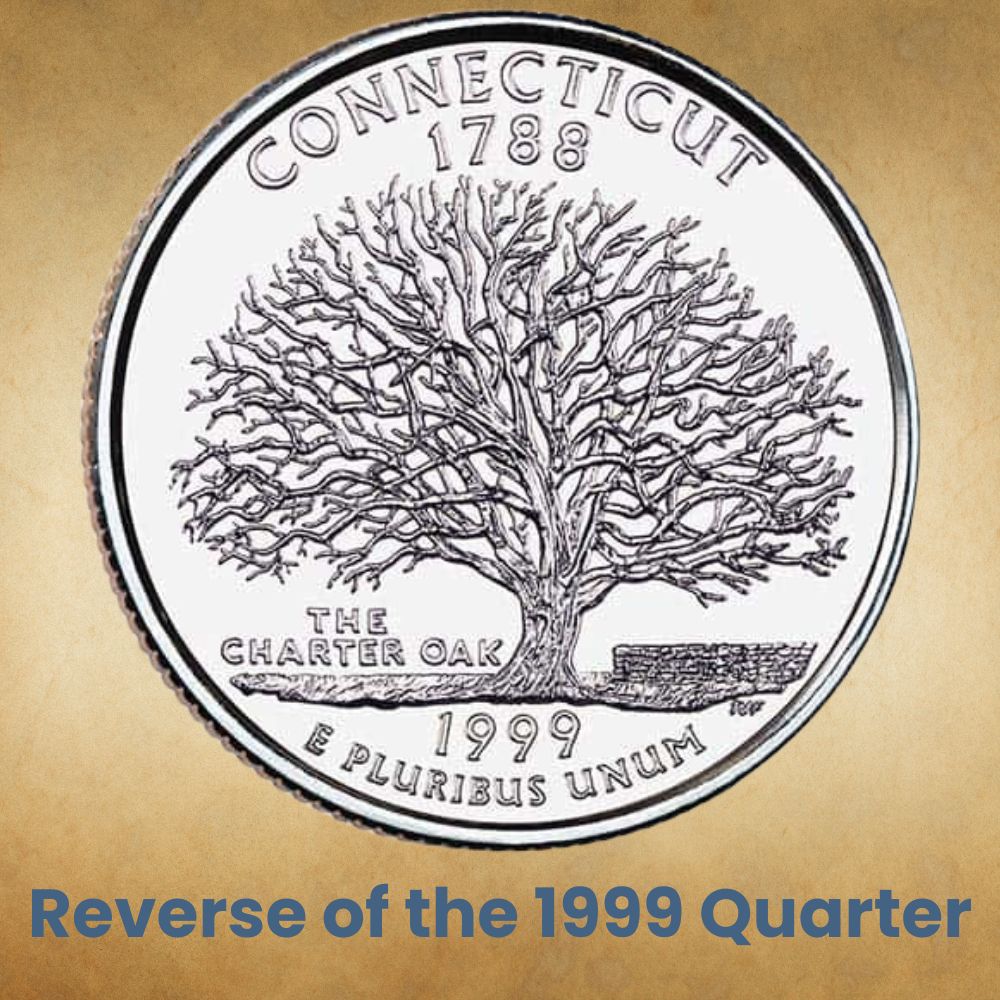
The reverse (tails side) of the 1999 Quarter has a template that gets modified for each state coin. At the top is the name of the state and the year it joined the Union. At the bottom is the mintage date followed by the motto E Pluribus Unum. The device itself will depend on the individual state and may include additional wording. Below are the five reverses from 1999.
| State Name | Year it Joined the Union | Coin Reverse Designer | Position of Designer’s Initials | Device Description |
| Delaware | 1787 | William Cousins | WC, Left, Near the Horse’s Front Hoof | Device: Caesar Rodney
Riding a Horse Legends: Caesar Rodney on the left, The First State on the Right. |
| Pennsylvania | 1787 | John Mercanti | JM, Right, Near Miss Penn’s Calf | Device: A Keystone, the Outline of the State of Pennsylvania, and a Statue of the Commonwealth aka Miss Penn, Letitia, or The Spirit of the Commonwealth.
Legends: Virtue, Liberty, Independence on the Right |
| New Jersey | 1787 | Alfred Maletsky | AM, Right, at the Corner Near the Boat | Device: Washington Crossing the Delaware in a boat that includes a Standing George Washington and James Monroe Carrying the Flag.
Legend: Crossroads of the Revolution, Above the Mintage Date |
| Georgia | 1787 | T. James Ferrell | TJF, Right, Under the Sprig | Device: A Peach Fruit, A Live Oak Which is the State Tree, and the Outline of the State of Georgia
Legends: Wisdom, Justice, Moderation in banners Surrounding the Peach |
| Connecticut | 1788 | T. James Ferrell | TJF, Right, Under the Stone Wall | Device: The Charter Oak with a Partial Stone Wall beside it.
Legend: The Charter Oak, Left, Under the Tree |
Other Features of the 1999 Quarter
In 1999, a total of 4,430,940,000 Quarters were minted in various styles. Technically, they were all Washington Quarters because they all had George Washington on the obverse, but they had 50 different reverse designs, one for each US State. These coins included clad coins for circulation, clad proofs for collectors, and silver proofs offered at a higher premium price.
All the coins were 24.3mm in diameter, 1.75mm thick, and had 119 reeds along their edges. The clad coins weighed 5.67g and were 91.67% copper and 8.33% nickel. The inner core was pure copper while the two outer layers were 75% copper and 25% nickel. Conversely, silver proof quarters from San Francisco were 90% silver and 10% copper. They weighed 6.25g.
Related Posts: 20 Most Valuable State Quarters Worth Money
FAQs About the 1999 Quarter
What is the Error on a 1999 Quarter?
The 1999 Quarter had five different designs so there’s plenty of scope for errors. But the most famous one is the Spitting Horse on the Delaware coin. It’s a mint error that makes it appear like the horse is spitting since a crack in the die transferred a slash below the horse’s mouth. It’s not an especially valuable error – it might net $40 or so in higher mint states like MS 65.
Related Posts: 21 Most Valuable Quarters In Circulation

I have 4 1999 quarters, Pennsylvania, Delaware,Georgia,Connecticut all have the D. How do I know if it has the MS66,Ms67,MS66 and what are the worth?